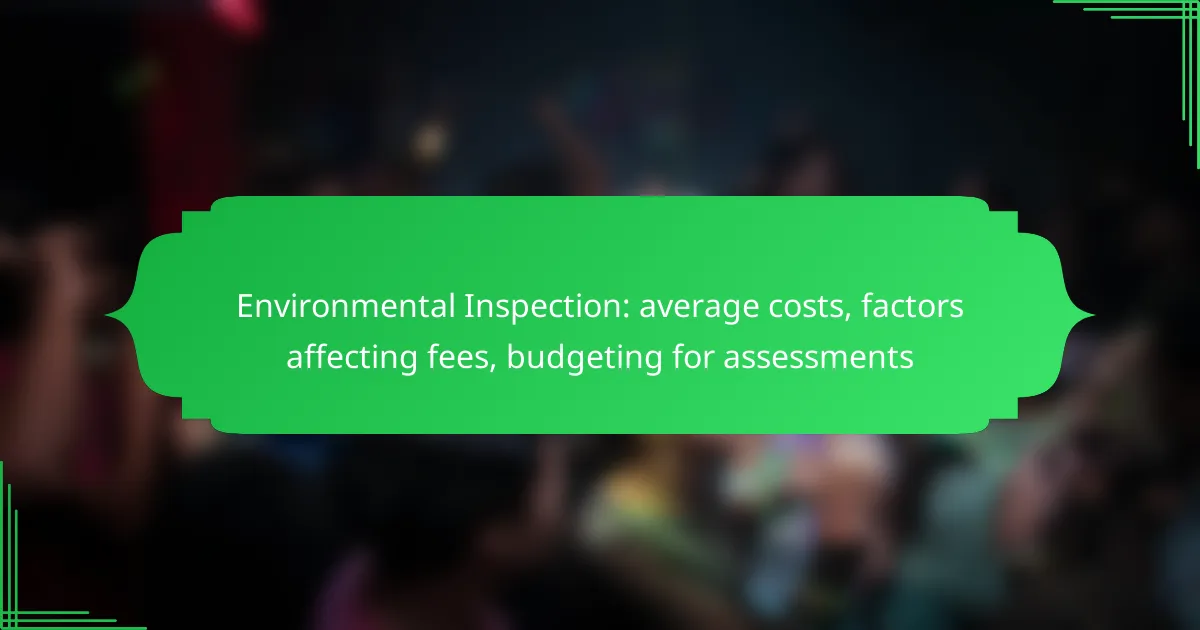Environmental inspections are essential for ensuring compliance with regulations and can range from a few hundred to several thousand dollars, influenced by the type and scope of the assessment. Understanding the factors that affect inspection fees is crucial for effective budgeting, allowing you to prepare for necessary evaluations without incurring unexpected expenses.
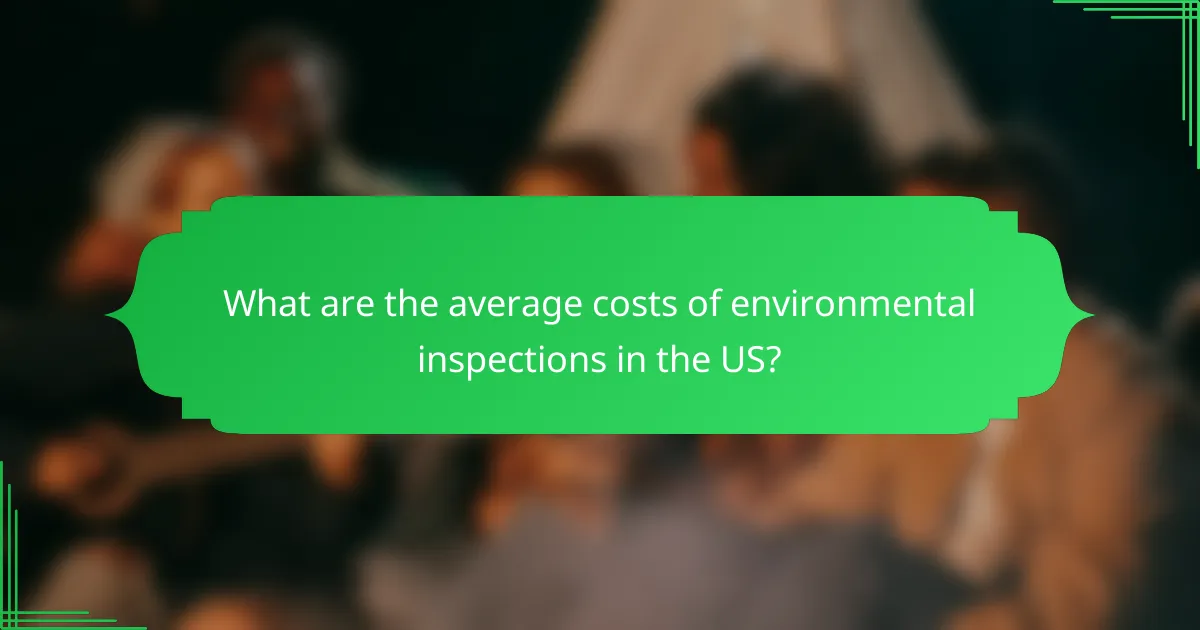
What are the average costs of environmental inspections in the US?
The average costs of environmental inspections in the US typically range from a few hundred to several thousand dollars, depending on various factors. These inspections assess compliance with environmental regulations and can vary significantly based on the type and scope of the assessment required.
Typical price range
Environmental inspection costs generally fall between $300 and $3,000. Basic assessments, such as Phase I Environmental Site Assessments (ESAs), usually start around $1,000, while more comprehensive evaluations, like Phase II ESAs, can exceed $2,500. Additional testing for specific contaminants may further increase costs.
Factors influencing costs
Moreover, the qualifications and experience of the inspecting firm can also affect pricing. Firms with specialized expertise or advanced technology may charge premium rates, but they often provide more thorough assessments.
Regional pricing variations
Pricing for environmental inspections can vary by region due to differences in local regulations, demand, and the cost of living. For example, inspections in urban areas or states with stricter environmental laws, such as California or New York, may be more expensive than in rural regions.
Additionally, regional market conditions can lead to fluctuations in service costs. It’s advisable to obtain quotes from multiple providers in your area to ensure competitive pricing and to understand the specific services included in the fee.
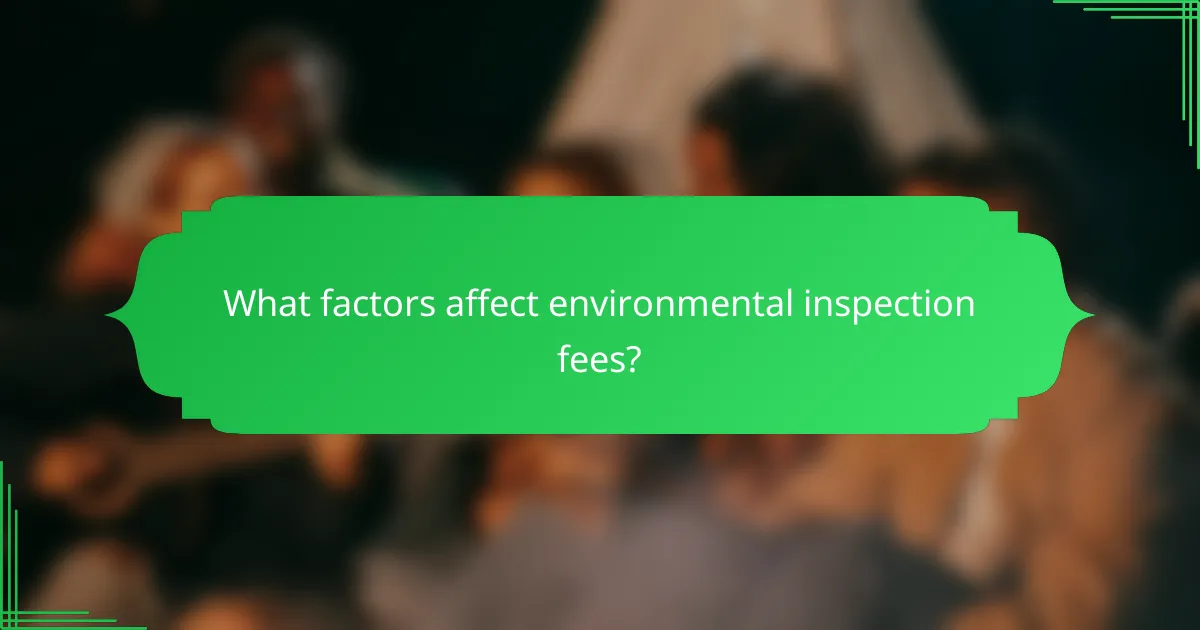
What factors affect environmental inspection fees?
Environmental inspection fees can vary significantly based on several key factors. Understanding these factors can help you budget effectively for assessments and avoid unexpected costs.
Type of inspection
The type of environmental inspection required plays a crucial role in determining the overall cost. Common types include Phase I Environmental Site Assessments (ESAs), Phase II ESAs, and specialized inspections for specific contaminants. Phase I assessments typically cost less, often ranging from a few hundred to a couple of thousand dollars, while Phase II assessments can be significantly more expensive due to the need for laboratory testing and more extensive fieldwork.
Size of the property
The size of the property being inspected directly influences the fees. Larger properties generally require more time and resources to assess, leading to higher costs. For example, inspecting a small residential lot may cost a few hundred dollars, while a large industrial site could run into the thousands, depending on the complexity of the inspection.
Location and accessibility
Geographic location and accessibility are significant factors affecting inspection fees. Properties in urban areas may incur higher costs due to increased labor rates and logistical challenges. Additionally, remote or hard-to-access locations may require specialized equipment or additional travel time, further increasing fees. For instance, inspections in metropolitan areas might be 20-30% more expensive than those in rural settings.
Specific contaminants tested
The specific contaminants being tested can also impact the cost of environmental inspections. Some contaminants, such as lead or asbestos, require specialized testing methods and equipment, which can drive up costs. Conversely, general assessments for common pollutants may be less expensive. It’s essential to clarify the scope of testing needed to get an accurate estimate, as specialized tests can add hundreds to thousands of dollars to the overall fee.
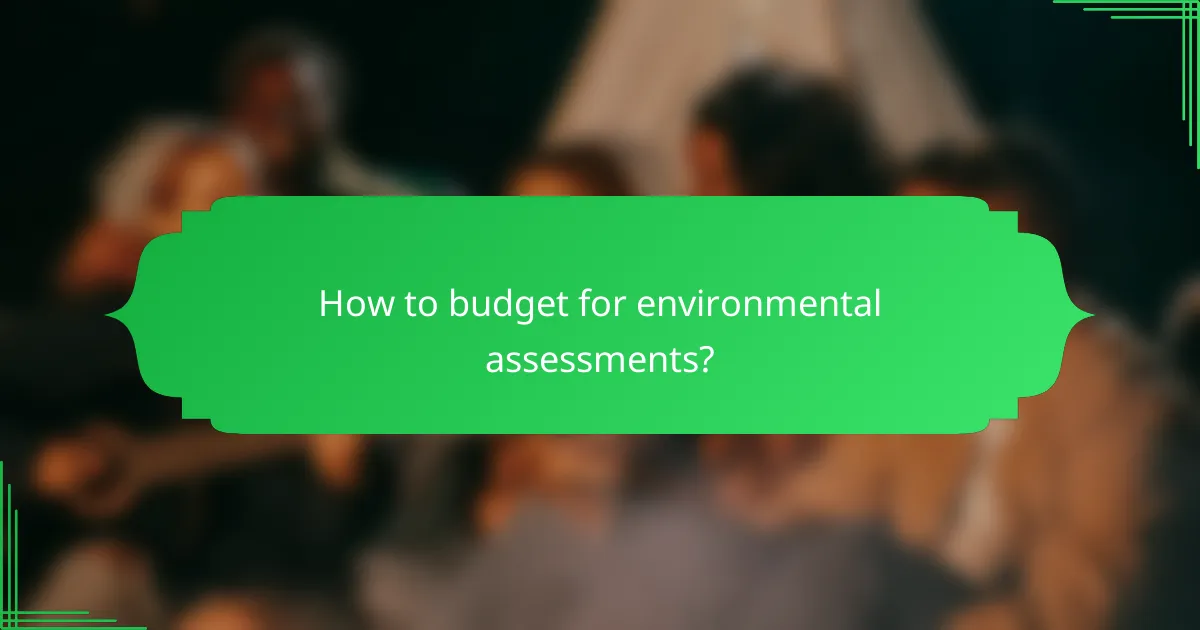
How to budget for environmental assessments?
Budgeting for environmental assessments involves understanding the potential costs and setting aside funds accordingly. This process ensures that you can cover necessary evaluations without financial strain.
Estimating total costs
Estimating total costs for environmental assessments typically ranges from a few hundred to several thousand dollars, depending on the project’s complexity and location. Factors influencing these costs include the size of the property, the type of assessment required, and local regulatory requirements.
For instance, a Phase I Environmental Site Assessment may cost between $1,500 and $3,000, while more comprehensive evaluations like Phase II assessments can range from $5,000 to $20,000 or more. It’s crucial to obtain multiple quotes from certified professionals to gauge the market rate.
Setting aside contingency funds
Setting aside contingency funds is essential when budgeting for environmental assessments. A common recommendation is to allocate an additional 10-20% of the estimated costs to cover unexpected expenses that may arise during the assessment process.
For example, if you estimate the assessment costs at $10,000, consider reserving an extra $1,000 to $2,000 for unforeseen issues such as additional testing or regulatory compliance requirements. This practice helps prevent budget overruns and ensures you can address any surprises that may come up.
Understanding payment structures
Understanding payment structures for environmental assessments can help you manage cash flow effectively. Many professionals offer various payment options, including fixed fees, hourly rates, or milestone payments based on project phases.
For instance, some firms may require an upfront retainer, while others might bill upon completion of specific assessment stages. Clarifying these terms before starting the project can help you budget more accurately and avoid any payment-related misunderstandings.
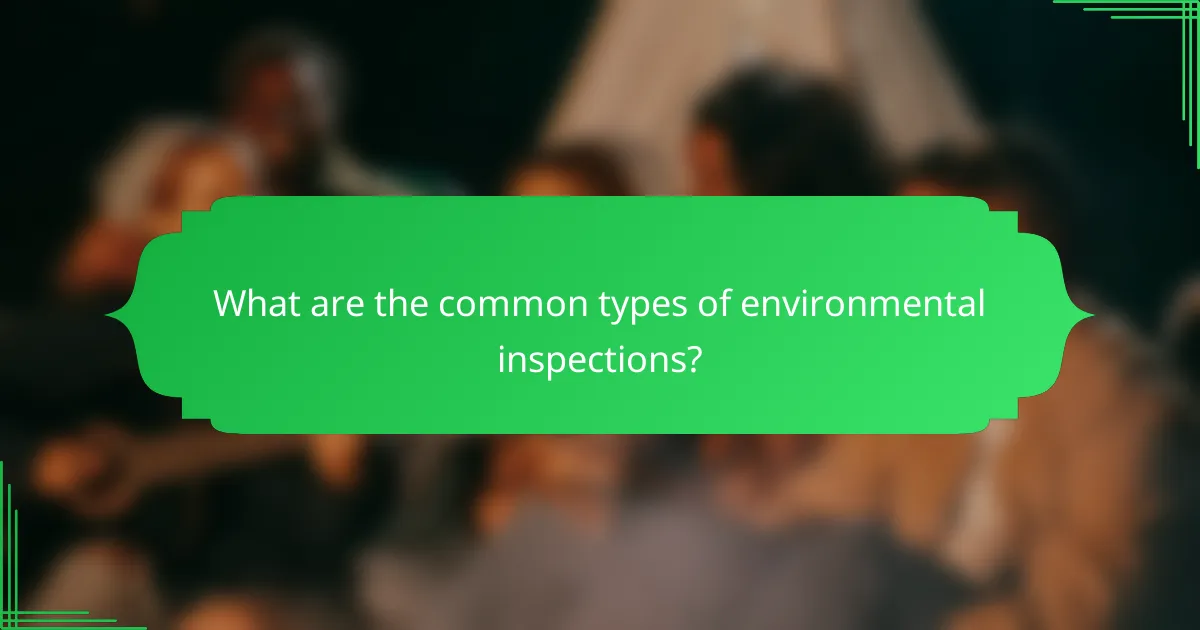
What are the common types of environmental inspections?
Common types of environmental inspections include assessments that evaluate potential contamination and hazards on a property. These inspections help identify environmental risks and ensure compliance with regulations, ultimately protecting public health and the environment.
Phase I Environmental Site Assessment
A Phase I Environmental Site Assessment (ESA) is a preliminary evaluation that identifies potential environmental contamination risks associated with a property. It typically involves a review of historical records, site inspections, and interviews with past owners or occupants.
This assessment usually costs between a few hundred to a couple of thousand USD, depending on the property’s size and location. It is often the first step in the due diligence process for real estate transactions.
Phase II Environmental Site Assessment
A Phase II Environmental Site Assessment follows a Phase I ESA when potential contamination is identified. This assessment includes soil and groundwater sampling and laboratory analysis to confirm the presence and extent of contaminants.
The costs for a Phase II ESA can range from several thousand to tens of thousands of USD, influenced by the complexity of the site and the number of samples required. It provides detailed information necessary for remediation planning if contamination is confirmed.
Asbestos inspections
Asbestos inspections are conducted to identify the presence of asbestos-containing materials (ACMs) in buildings, which can pose serious health risks. These inspections typically involve visual assessments and sampling of suspect materials.
The cost of asbestos inspections varies widely, generally falling between a few hundred to several thousand USD, depending on the building size and the number of samples taken. It is crucial for property owners to conduct these inspections before renovations or demolitions to comply with safety regulations.

What are the prerequisites for conducting an environmental inspection?
Before conducting an environmental inspection, it is essential to understand the necessary prerequisites, including compliance with regulations and the hiring of qualified professionals. These factors significantly influence the effectiveness and legality of the inspection process.
Regulatory compliance requirements
Regulatory compliance is crucial for any environmental inspection. Inspectors must be familiar with local, state, and federal regulations that govern environmental standards. This includes understanding laws related to waste management, air quality, and water protection.
To ensure compliance, it is advisable to review the specific regulations that apply to the inspection area. For example, in the United States, the Environmental Protection Agency (EPA) sets forth guidelines that must be adhered to, while in Europe, the European Union has its own directives. Non-compliance can lead to significant fines and legal repercussions.
Hiring qualified professionals
Hiring qualified professionals is a key step in conducting an effective environmental inspection. Look for individuals or firms with relevant certifications and experience in environmental assessments. This may include certifications from recognized bodies such as the Institute of Environmental Management and Assessment (IEMA) or similar organizations.
When selecting professionals, consider their track record in similar inspections and their familiarity with local regulations. It is often beneficial to request references or case studies to gauge their expertise. Investing in qualified personnel can ultimately save time and resources by ensuring thorough and compliant inspections.
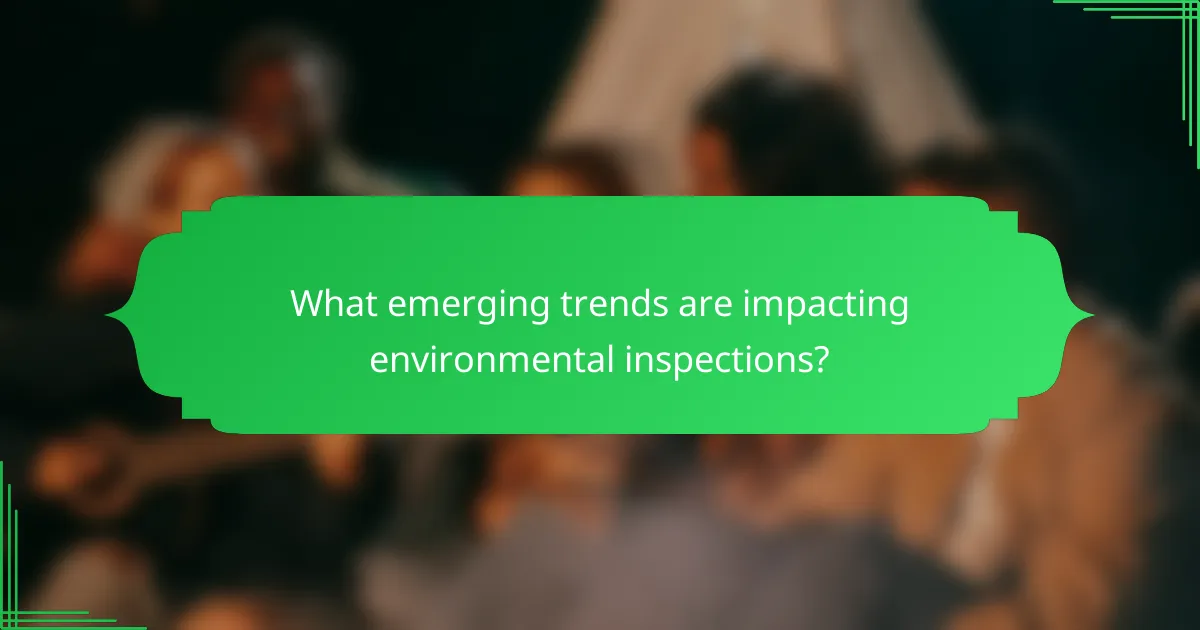
What emerging trends are impacting environmental inspections?
Emerging trends such as technological advancements, regulatory changes, and increased public awareness are significantly impacting environmental inspections. These factors are reshaping how assessments are conducted, influencing costs, and altering the expectations of stakeholders.
Technological advancements
Technological advancements are revolutionizing environmental inspections by improving accuracy and efficiency. Tools like drones, remote sensing, and advanced data analytics allow inspectors to gather information quickly and with minimal disruption to the environment.
For example, drones can cover large areas in a fraction of the time it would take a team on foot, while data analytics can identify patterns and potential issues that may not be visible during a traditional inspection. This can lead to cost savings and more effective assessments.
When budgeting for inspections, consider investing in these technologies as they can reduce long-term costs and enhance the quality of the inspections. However, ensure that your team is trained to use these tools effectively to avoid common pitfalls associated with new technology.
